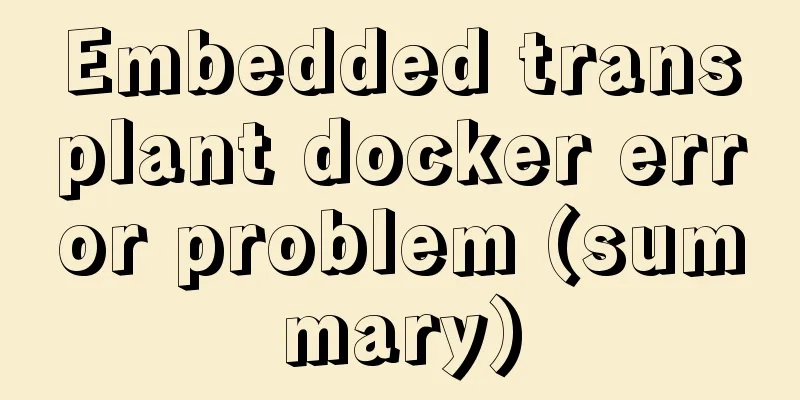Join operation in Mysql

|
Types of joins 1. Inner join: The fields in the two tables that have a join relationship form a record set that joins those records that meet the join relationship. 2. Outer join: divided into outer left join and outer right join. Case Background
create table java (name varchar(255));
insert into java values ('java1'),('java2'),('blue');
create table mysql (name varchar(255));
insert into mysql values ('mysql1'),('mysql2'),('blue');Inner Join select * from java,mysql where java.name=mysql.name; SELECT * FROM java JOIN mysql ON java.name=mysql.name; SELECT * FROM java INNER JOIN mysql ON java.name=mysql.name; SELECT * FROM java CROSS JOIN mysql ON java.name=mysql.name; SELECT * FROM java STRAIGHT_JOIN mysql ON java.name=mysql.name; These four statements are all inner joins, and the returned results are +------+------+ | name | name | +------+------+ | blue | blue | +------+------+
The syntax for an inner join is as follows: join_table: table_reference [INNER | CROSS] JOIN table_factor [join_condition] | table_reference STRAIGHT_JOIN table_factor | table_reference STRAIGHT_JOIN table_factor ON condition Outer Join Left Join SELECT * FROM java LEFT JOIN mysql ON java.name=mysql.name; turn out +-------+------+ | name | name | +-------+------+ | java1 | NULL | | java2 | NULL | | blue | blue | +-------+------+ Therefore, from the above results, we can see that because the name of the java1 and java2 records in the Java table has no corresponding name in the MySQL table, it is empty, but all the columns of java still have java1 and java2 records, and all the columns of the mysql table are NULL. The remaining blue record is the result of the inner join between the Java table and the MySQL table. If there are no matching records for the right table in the ON or USING part of a LEFT JOIN, a row with all columns set to NULL is used for the right table. You can use this method to find records in a table that has no corresponding part in another table: SELECT * FROM java LEFT JOIN mysql ON java.name=mysql.name WHERE mysql.name IS NULL; This sql finds people who are in java but not in mysql. Obviously, people 'java1' and 'java2' meet the requirement. Right Join SELECT * FROM java RIGHT JOIN mysql ON java.name=mysql.name; The result returned is +------+--------+ | name | name | +------+--------+ | NULL | mysql1 | | NULL | mysql2 | | blue | blue | +------+--------+ The right join has similar results to the left join, except that this time the mysql table holds all the result sets. Outer Join Syntax join_table:| table_reference LEFT [OUTER] JOIN table_reference join_condition | table_reference NATURAL [LEFT [OUTER]] JOIN table_factor | table_reference RIGHT [OUTER] JOIN table_reference join_condition | table_reference NATURAL [RIGHT [OUTER]] JOIN table_factor USING(column_list) Clause Used to name a series of columns that must exist in both tables. SELECT java.*,mysql.* FROM java LEFT JOIN mysql USING (name); Results +-------+------+ | name | name | +-------+------+ | java1 | NULL | | java2 | NULL | | blue | blue | +-------+------+ Order of operations for joins SELECT * FROM t1 LEFT JOIN (t2, t3, t4) ON (t2.a=t1.a AND t3.b=t1.b AND t4.c=t1.c); --Equivalent to SELECT * FROM t1 LEFT JOIN (t2 CROSS JOIN t3 CROSS JOIN t4) ON (t2.a=t1.a AND t3.b=t1.b AND t4.c=t1.c) Effect of parentheses on join order SELECT t1.id,t2.id,t3.id FROM t1,t2 LEFT JOIN t3 ON (t3.id=t1.id) WHERE t1.id=t2.id; --Actually, the execution is: SELECT t1.id, t2.id, t3.id FROM t1, ( t2 LEFT JOIN t3 ON (t3.id=t1.id) ) WHERE t1.id=t2.id; --Should be written like this: SELECT t1.id,t2.id,t3.id FROM (t1,t2) LEFT JOIN t3 ON (t3.id=t1.id) WHERE t1.id=t2.id; The brackets are very important here, so when writing such queries in the future, don't forget to write a few more brackets, at least this can avoid many errors The above is the Mysql join operation introduced by the editor. I hope it will be helpful to everyone. If you have any questions, please leave me a message and the editor will reply to you in time. I would also like to thank everyone for their support of the 123WORDPRESS.COM website! You may also be interested in:
|
<<: How to set static IP for Ubuntu 18.04 Server
>>: A complete example of implementing a timed crawler with Nodejs
Recommend
Detailed example of using typescript to encapsulate axios in Vue3
This axios package is used in the vue3 demo. For ...
React Native startup process detailed analysis
Introduction: This article takes the sample proje...
mysql8.0.0 winx64.zip decompression version installation and configuration tutorial
This article records the installation tutorial of...
How to use JS to parse the excel content in the clipboard
Table of contents Preface 1. Paste Events and Cli...
MySQL5.6.31 winx64.zip installation and configuration tutorial
#1. Download # #2. Unzip to local and modify nece...
A general method for implementing infinite text carousel with native CSS
Text carousels are very common in our daily life....
Detailed explanation of the encapsulation and use of the Vue image magnifier component
Based on the Vue image magnifier component packag...
Implementation of Nginx load balancing/SSL configuration
What is load balancing? When a domain name points...
Summary of the differences between MySQL storage engines MyISAM and InnoDB
1. Changes in MySQL's default storage engine ...
Detailed explanation of count(), group by, order by in MySQL
I recently encountered a problem when doing IM, a...
View the frequently used SQL statements in MySQL (detailed explanation)
#mysql -uroot -p Enter password mysql> show fu...
Application of dynamic image loading technology and use case of jquery.lazyload plug-in
Application example website http://www.uhuigou.net...
VPS builds offline download server (post-network disk era)
motivation Due to learning needs, I purchased a v...
Set the default text of the search box. The default text disappears when the mouse is clicked.
Copy code The code is as follows: <input type=...
MySQL query statement process and basic concepts of EXPLAIN statement and its optimization
The performance of your website or service depend...









